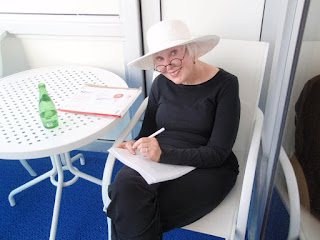By
Carolyn Howard-Johnson
Author
of The Frugal Editor, the winning-est in her
award-winning HowToDoItFrugally Series of books for writers
This
article is excerpted from some editing I did for a writer of
experimental fiction when I was on a Greater Los Angeles Writers
Society panel writer of any genre can apply these suggestions to the
chase, getaway, or high action scene in your script or manuscript
before you send it to an agent or publisher or, better still, while
you are writing the first draft.
Sometimes
even the most fascinating, interesting and irresistible detail can
slow down the forward movement of your story. So as much as writers
are told that detail is important, purge as much as you can from your
action scenes and put it somewhere else or dribble it into narrative
in other places in your manuscript. In the process, ask yourself if
your reader really needs to know the color of the protagonist’s
eyes. As important as detail is, some is better left to the
imagination of the reader. I can imagine where eye color might be
very important, but—on average—it probably isn’t necessary.
Here are some quick suggestions:
1. Remove
some of the detail entirely. Double check. Make it meet the test!
2. Use
stronger verbs—especially verbs of movement.
3. Use
shorter sentences. By doing so, the rhythm could emulate a
fast-beating heart and the pulse of danger. Note that clauses slow
copy as surely as passive voice (or tense).
4. In
the interest of a faster pace, try dropping into present tense and
moving out of it when the run or danger is past. If you write the
scene that way and wait a day or two before rereading it. By doing
so, you’ll be able to honestly compare the effects of the two and
adjust the tense change so it doesn’t feel obtrusive.
5. If
you are trying to achieve a truly heart-beating moment, consider
using fragments. Even one-word fragments.
6. Commas
can slow the pace. Sometimes you must follow grammar rules for commas
for clarity. Often that comma slows things down for the reader. Does
the comma indicate a pause where the reader wouldn’t normally pause
or does it reinforce a natural
pause.
Does it really help with clarity. Would you achieve this clarity
better if you made your long sentence into short ones. This is a
style choice you get to make. You are looking for the times readers
will never notice a comma is absent.
You
may choose to discard some of them.
7. Consider
saving the description of your protagonist for a time when life
doesn’t depend on his or her speed. His “bright face of youth”
doesn’t meet that test. Is there a way to work the major
description into this narrative using smaller bites or to arrange to
have it come before or after the chase?
8. Though
I love include some sensory detail, be careful not to overdo that,
especially in an action-moment. The writer of the action scene I was
critiquing had the protagonist leaning against a strut for a moment’s
rest. The strut’s sensory role in this passage should probably be
the emotional reassurance it offered, not how it felt to the touch.
Further, this kind of thing might best be left to your reader who
will draw that conclusion anyway.
9. At
the risk of being repetitious, the sense of danger shouldn’t be
interrupted unless it is necessary for understanding. Sometimes that
isn’t speed (like a chase). Sometimes it is. Regardless, you—the
author—want to keep the momentum going for the reader.
ABOUT
THE AUTHOR
Carolyn
Howard-Johnson is the author of the multi award-winning series of
HowToDoItFrugally books for writers including USA Book News’ winner
for The
Frugal Book Promoter.
An instructor for UCLA Extension's renowned Writers Program for
nearly a decade, she believes in entering (and winning!) contests and
anthologies as an excellent way to separate our writing from the
hundreds of thousands of books that get published each year. Two of
her favorite awards are Woman of the Year in Arts and Entertainment
given by members of the California Legislature and Women Who Make
Life Happen, given by the Pasadena
Weeklynewspaper.
She is also an award-winning poet and novelist and she loves passing
along the tricks of the trade she learned from marketing those
so-called hard-to-promote genres. Learn more and find tons of free
resources on her website at https://HowToDoItFrugally.comor
on her Amazon profile page: https://bit.ly/CarolynsAmznProfile.
While you’re there, won’t you click on the follow button and make
sure your Amazon profile page is up-to-date.
Author
of the multi award-winning HowToDoItFrugally Series of books for
writers including
Website:
https://www.howtodoitfrugally.com
Amazon
Profile - bit.ly/CarolynsAmznProfile
Twitter
- @FrugalBookPromo
Celebrating:
bit.ly/NonfictionAuthorAssocFeaturedAuthor



Comments
Post a Comment